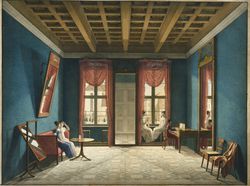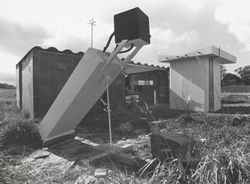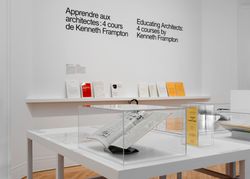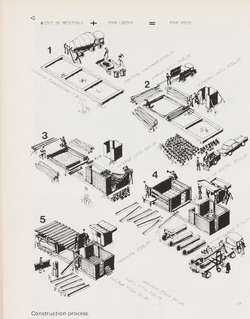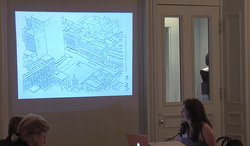documents textuels
AP197.S3.006
Description:
The box is comprised of correspondence for the years of 1995-1997, organized in chronological order. The box documents Frampton’s career as Ware professor at the Graduate School of Architecture, Planning and Preservation, Columbia University and his related professional activities. Correspondence in this box includes: offers of teaching positions; requests to write articles, reviews, books and recommendation letters; invitations to teach, present, or attend at lectures/symposiums/conferences; and requests to serve on juries. Throughout this period, Frampton corresponded with various architects, professors, publishers, and editors of various publications such as: Thames and Hudson Ltd.; the Berlage Institute; the Italian Cultural Institute; Yukio Futagawa of GA/ADA Edita Tokyo Co CD; and the MIT Press. Correspondence relates to his participation/involvement in: the Michael Blackwood Production “In search of Louis Kahn: Six Buildings;” the Japanese and German translations for the Studies in Tectonic Culture publication; organizing lectures on Studies in tectonic Culture; the Jerusalem Seminar in Architecture “Technology, Place & and Architecture;” teaching at the École polytechnique fédérale de Lausanne; the Aga Khan Program for Islamic Architecture; and the Architectural Society of China. Correspondence concerning the following publications and lectures is included: “the Megaform as City in Miniature;” “Critical regionalism revisited,” a lecture at the Berlage Institute; the Le Corbusier publication; “Tradition and Innovation in the Work of Christoph Mackler;” and the forward for Vittorio Gregotti`s Inside Architecture.
1995-1997
Personal and professional correspondence from 1995-1997
Actions:
AP197.S3.006
Description:
The box is comprised of correspondence for the years of 1995-1997, organized in chronological order. The box documents Frampton’s career as Ware professor at the Graduate School of Architecture, Planning and Preservation, Columbia University and his related professional activities. Correspondence in this box includes: offers of teaching positions; requests to write articles, reviews, books and recommendation letters; invitations to teach, present, or attend at lectures/symposiums/conferences; and requests to serve on juries. Throughout this period, Frampton corresponded with various architects, professors, publishers, and editors of various publications such as: Thames and Hudson Ltd.; the Berlage Institute; the Italian Cultural Institute; Yukio Futagawa of GA/ADA Edita Tokyo Co CD; and the MIT Press. Correspondence relates to his participation/involvement in: the Michael Blackwood Production “In search of Louis Kahn: Six Buildings;” the Japanese and German translations for the Studies in Tectonic Culture publication; organizing lectures on Studies in tectonic Culture; the Jerusalem Seminar in Architecture “Technology, Place & and Architecture;” teaching at the École polytechnique fédérale de Lausanne; the Aga Khan Program for Islamic Architecture; and the Architectural Society of China. Correspondence concerning the following publications and lectures is included: “the Megaform as City in Miniature;” “Critical regionalism revisited,” a lecture at the Berlage Institute; the Le Corbusier publication; “Tradition and Innovation in the Work of Christoph Mackler;” and the forward for Vittorio Gregotti`s Inside Architecture.
documents textuels
1995-1997
recherche
Subventions de recherche Groupe Banque TD dans la collection du CCA : Pep Avilés (Princeton University); Julia Morgan Charles (McGill University); Duks Koschitz (Massachusetts Institute of Technology); Alessandra Mariani (UQàM - Université du Québec à Montréal); Andrea Merrett (Columbia University); Yetunde Olaiya (Princeton University); Daria Ricchi (Princeton(...)
juin 2012 au août 2012
Programme pour les doctorants 2012
Actions:
Description:
Subventions de recherche Groupe Banque TD dans la collection du CCA : Pep Avilés (Princeton University); Julia Morgan Charles (McGill University); Duks Koschitz (Massachusetts Institute of Technology); Alessandra Mariani (UQàM - Université du Québec à Montréal); Andrea Merrett (Columbia University); Yetunde Olaiya (Princeton University); Daria Ricchi (Princeton(...)
recherche
juin 2012 au
août 2012
Voir, apercevoir, regarder, envisager : chacune de ces actions est une forme d’encadrement qui offre une médiation entre le dedans et le dehors, le public et le privé, le manifeste et le caché. Georges Teyssot, professeur à l’École d’Architecture de l’Université Laval à Québec et auteur du livre A Topology of Everyday Constellations (The MIT Press, 2013), analyse comment(...)
Maison Shaughnessy
19 février 2015 , 18h
Fenêtres et écrans : Georges Teyssot
Actions:
Description:
Voir, apercevoir, regarder, envisager : chacune de ces actions est une forme d’encadrement qui offre une médiation entre le dedans et le dehors, le public et le privé, le manifeste et le caché. Georges Teyssot, professeur à l’École d’Architecture de l’Université Laval à Québec et auteur du livre A Topology of Everyday Constellations (The MIT Press, 2013), analyse comment(...)
Maison Shaughnessy
Dans la série de conférences Hier d’aujourd’hui, l’architecte et auteur canadien Witold Rybczynski expose les origines de l’Ecol House, prototype d’un modèle d’habitation autonome pour les pays en développement. Le projet a été créé à Montréal en 1972 par Ecol Operation, un groupe d’architectes et d’étudiants duquel il était membre et qui devient, au début des années(...)
Théâtre Paul-Desmarais
29 novembre 2007
Witold Rybczynski : Green Before Green
Actions:
Description:
Dans la série de conférences Hier d’aujourd’hui, l’architecte et auteur canadien Witold Rybczynski expose les origines de l’Ecol House, prototype d’un modèle d’habitation autonome pour les pays en développement. Le projet a été créé à Montréal en 1972 par Ecol Operation, un groupe d’architectes et d’étudiants duquel il était membre et qui devient, au début des années(...)
Théâtre Paul-Desmarais
recherche
Subventions de recherche Groupe Banque TD dans la collection du CCA : Jordan Kauffman (Massachusetts Institute of Technology); Julia Tischer (McGill University); Mariana Mogilevich (Harvard University); Elizabeth McFarland (Cornell University); Alexandra Quantrill (Columbia University); Enrique Ramirez (Princeton University); Yoonchun Jung (McGill University); Mark(...)
février 2011 au novembre 2011
Programme pour les doctorants 2011
Actions:
Description:
Subventions de recherche Groupe Banque TD dans la collection du CCA : Jordan Kauffman (Massachusetts Institute of Technology); Julia Tischer (McGill University); Mariana Mogilevich (Harvard University); Elizabeth McFarland (Cornell University); Alexandra Quantrill (Columbia University); Enrique Ramirez (Princeton University); Yoonchun Jung (McGill University); Mark(...)
recherche
février 2011 au
novembre 2011
Lors de la réforme de l’enseignement dans les écoles d’architecture américaines durant les années 1970, Kenneth Frampton a joué un rôle de premier plan dans la transformation du programme de la Graduate School of Architecture Planning de Columbia University. Il a notamment créé et enseigné les trois cours de base du programme: le séminaire théorique «Comparative Critical(...)
Salle octogonale Mot(s)-clé(s):
Kenneth Frampton, Columbia, Princeton, teaching, GSAPP
31 mai 2017 au 24 septembre 2017
Apprendre aux architectes : quatre cours de Kenneth Frampton
Actions:
Description:
Lors de la réforme de l’enseignement dans les écoles d’architecture américaines durant les années 1970, Kenneth Frampton a joué un rôle de premier plan dans la transformation du programme de la Graduate School of Architecture Planning de Columbia University. Il a notamment créé et enseigné les trois cours de base du programme: le séminaire théorique «Comparative Critical(...)
Salle octogonale Mot(s)-clé(s):
Kenneth Frampton, Columbia, Princeton, teaching, GSAPP
Les trois lauréates du prix Power Corporation du Canada, Lisa Chow (McGill University), Michèle Curtis (Carleton University) et Geneviève Depelteau (University of British Columbia), présentent les résultats de leur résidence de recherche de trois mois au CCA. Au cours de cette résidence, elles ont étudié l’émergence d’une conscience environnementale en architecture et en(...)
Maison Shaughnessy
1 septembre 2016, 18h
Le problème est-il… encore l’environnement?
Actions:
Description:
Les trois lauréates du prix Power Corporation du Canada, Lisa Chow (McGill University), Michèle Curtis (Carleton University) et Geneviève Depelteau (University of British Columbia), présentent les résultats de leur résidence de recherche de trois mois au CCA. Au cours de cette résidence, elles ont étudié l’émergence d’une conscience environnementale en architecture et en(...)
Maison Shaughnessy
Olumuyiwa Adegun, chercheur en résidence 2016, présente ses recherches : Les villes d’Europe au XIXe siècle, à l’instar des villes d’Afrique aujourd’hui, ont souffert de graves problèmes de logement. Les bidonvilles ont marqué Berlin et Paris, tout comme dans les dernières décennies, le logement informel est devenu un trait particulier de Nairobi et de Johannesburg.(...)
Maison Shaughnessy
4 août 2016, 18h
Séminaire de chercheur en résidence : Olumuyiwa Adegun
Actions:
Description:
Olumuyiwa Adegun, chercheur en résidence 2016, présente ses recherches : Les villes d’Europe au XIXe siècle, à l’instar des villes d’Afrique aujourd’hui, ont souffert de graves problèmes de logement. Les bidonvilles ont marqué Berlin et Paris, tout comme dans les dernières décennies, le logement informel est devenu un trait particulier de Nairobi et de Johannesburg.(...)
Maison Shaughnessy
Michela Rosso, allocataire d’une bourse d’appui en 2013, présente sa recherche dans les archives de Peter Carter sur le schéma du manoir carré (1962-1985) et montre les différentes facettes de la controverse entourant la tour non construite de Mies van der Rohe, au cœur de Londres. Michela Rosso a obtenu un doctorat de l’École polytechnique de Turin, où elle est depuis(...)
Maison Shaughnessy
30 mai 2013, 18h
« Friends and Enemies of Mies’s Mansion House Square »
Actions:
Description:
Michela Rosso, allocataire d’une bourse d’appui en 2013, présente sa recherche dans les archives de Peter Carter sur le schéma du manoir carré (1962-1985) et montre les différentes facettes de la controverse entourant la tour non construite de Mies van der Rohe, au cœur de Londres. Michela Rosso a obtenu un doctorat de l’École polytechnique de Turin, où elle est depuis(...)
Maison Shaughnessy
L’enseignement de… Bombay
Rahul Mehrotra livre son interprétation de la situation propre à la ville de Bombay et de son statut de symbole de la culture urbaine émergente en Inde. La conférence fait le point sur Bombay, mégalopole de plus de13 millions d’habitants et s’attarde sur les deux entités distinctes occupant le même espace physique qui la caractérisent : d’une part, la ville dans ce(...)
Théâtre Paul-Desmarais
9 avril 2009
L’enseignement de… Bombay
Actions:
Description:
Rahul Mehrotra livre son interprétation de la situation propre à la ville de Bombay et de son statut de symbole de la culture urbaine émergente en Inde. La conférence fait le point sur Bombay, mégalopole de plus de13 millions d’habitants et s’attarde sur les deux entités distinctes occupant le même espace physique qui la caractérisent : d’une part, la ville dans ce(...)
Théâtre Paul-Desmarais
